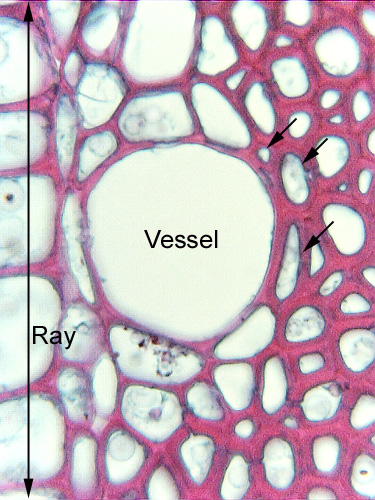Up
Intro: dicot wood
Intro: conifer wood
Intro: pine wood
Intro: annual rings
Pine tan s, ray
Pine xs, ray
Pine tan s, CBP
Pine rs, ray tracheids
Pine rs, ray
Fir rs, living rays
Manoxylic wood
Pine xs, CBP
CBP
Cambial record
Pine rs, tracheids
Dicot, primary ray
Living ray cells
Distorted rays
Uni-, multiseriate rays
Aggregate ray
Upright, procumbent cells
Sclerified ray
Cactus ray
Vessel radii
Solitary vessels
Clustered vessels
Vessels in chains
Ring, diffuse porous
Tyloses
Diffuse parenchyma
Banded parenchyma
Scanty paratracheal
Parenchymatous wood
Dimorphic wood 1
Dimorphic wood 2
| |
 Fig.
15.3-17. Transverse section of wood of a cactus (Acanthocereus
columbianus). This wood has scanty
paratracheal parenchyma. It is paratracheal because each
parenchyma cell is in contact with a vessel, and it is scanty because it
does not completely ensheath the vessel (arrows indicate three fibers that touch
the vessel). Notice also that this vessel is close to a ray: the water that the
cactus stores in its thick, succulent cortex can travel easily through the ray
and then to the vessel. Fig.
15.3-17. Transverse section of wood of a cactus (Acanthocereus
columbianus). This wood has scanty
paratracheal parenchyma. It is paratracheal because each
parenchyma cell is in contact with a vessel, and it is scanty because it
does not completely ensheath the vessel (arrows indicate three fibers that touch
the vessel). Notice also that this vessel is close to a ray: the water that the
cactus stores in its thick, succulent cortex can travel easily through the ray
and then to the vessel.
|
 Fig.
15.3-17. Transverse section of wood of a cactus (Acanthocereus
columbianus). This wood has scanty
paratracheal parenchyma. It is paratracheal because each
parenchyma cell is in contact with a vessel, and it is scanty because it
does not completely ensheath the vessel (arrows indicate three fibers that touch
the vessel). Notice also that this vessel is close to a ray: the water that the
cactus stores in its thick, succulent cortex can travel easily through the ray
and then to the vessel.
Fig.
15.3-17. Transverse section of wood of a cactus (Acanthocereus
columbianus). This wood has scanty
paratracheal parenchyma. It is paratracheal because each
parenchyma cell is in contact with a vessel, and it is scanty because it
does not completely ensheath the vessel (arrows indicate three fibers that touch
the vessel). Notice also that this vessel is close to a ray: the water that the
cactus stores in its thick, succulent cortex can travel easily through the ray
and then to the vessel.